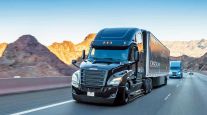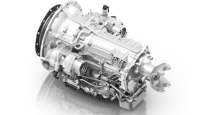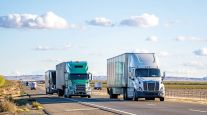Senior Reporter
ZF Showcases Autonomous Braking, Other Systems
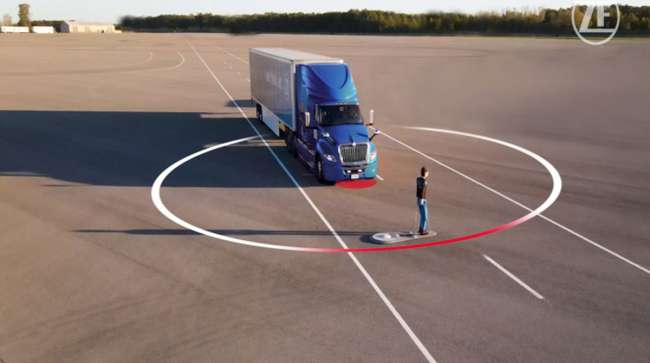
[Stay on top of transportation news: Get TTNews in your inbox.]
EAST LIBERTY, Ohio — ZF’s Commercial Vehicle Systems Division showcased separately on two heavy-duty trucks its OnGuardMax autonomous emergency braking system and its adjustable electric power steering feature — both coming soon to the North American market.
The event convened Oct. 11 at the nonprofit Transportation Research Center Inc., where ZF has a 16,000-square-foot testing and development hub.
ZF’s tests of its Class 8 cutting-edge technology were done on an asphalt pad, but the Transportation Research Center includes multiple test courses and tracks nestled amid a 4,500-acre setting with tall trees, fields and cattail-spiked wetlands.
Germany-based ZF’s North American headquarters is in Northfield, Mich. It also showcased here its eBeam electric axle for the medium-duty pickups, which remains in final development. It was quiet and smooth, with various settings for torque and braking along a two-lane hilly road.
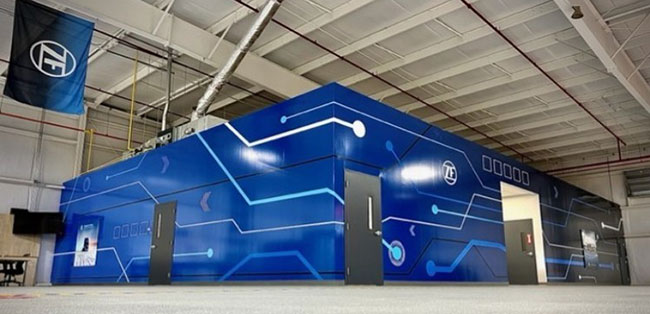
ZF's CV development test development hub. (ZF)
Its PowerLine eight-speed automatic transmission was in a medium-duty box truck — with that product launch expected in North America in spring 2023, according to the company, and built at its Gray Court, S.C., plant where it has invested $200 million.
In 2020, ZF acquired commercial vehicle technology supplier Wabco Holdings Inc. for $7.1 billion and it became ZF’s Commercial Vehicle Solutions division this year.
“We are not really focusing on having a large collection of products. We are really interested in how those products are going to work in a system together,” said Julien Plenchette, senior vice president of Americas at ZF’s Commercial Vehicle Solutions division.
ZF has four technology domains: vehicle motion control, automated driving, integrated safety and electric mobility — resting on software and digitalization. The aftermarket accounts for 25% of its business in North and South America and globally it’s probably 30%, he said. “We are looking at the services we can provide with that, and expanding on that.”
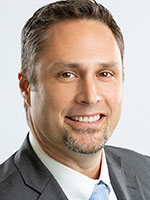
Plenchette
OnGuardMax 2.0 is the newest version of its advanced driver-assistance system and uses both dual-lens cameras and short-range radar, Plenchette said. Electric power steering is its next step toward steer-by-wire (technologies that replace mechanical controls, like throttles and steering linkages, with electronic systems, according to experts), “both for electrification but also to simplify the overall steering system and reducing total cost of ownership, complexity and the number of components.”
It is coming to market in the second quarter of 2023, the company reported.
A demonstration of the OnGuardMax 2.0 autonomous emergency braking system was initiated at just under 50 mph as the Class 8 bore down on a mock-up of a stationary car directly ahead.
The truck drew closer; at the first warning the system applied the brakes to slow the truck and get the driver’s attention; but it kept going too fast. The second and final braking event took place and stopped the truck within a few feet of the stand-in for a car.
What was remarkable about the last braking event was how mostly smooth it felt given the sudden, quick deceleration — but not causing a slamming, herky-jerky reaction to be felt by those seated in the cab.
Technically, the OnGuard camera identified the surrogate car. The system requested a certain amount of initial and additional deceleration — it did not just order a one-time slam on the brakes. How smooth it all felt was a result of the ABS system that measured the deceleration rate, adjusted and readjusted, according to the company.
It performed as well later when detecting a cardboard bicyclist straight ahead. In neither case was the system meant to replace the driver’s keen situational awareness.
Also, the industry is transitioning to electric steering from hydraulic steering, like the auto industry did 15 years ago, said Joe Harter, application lead at ZF, during that test run.
At ZF, the electric power steering system is maintenance free since there is only the motor and gear system, no hoses, reservoirs, brackets, fluids or filters, he said. It can qualify for greenhouse gas credits since it eliminates the horsepower — saving fuel — used to run a hydraulic pump when going straight down the road. Harter called that a “complete waste of energy.”
Want more news? Listen to today's daily briefing above or go here for more info
Its system is programmable by the driver so that it can have the same stiffness as hydraulic, or higher, for instance. Or it can steer easy such as when doing parking lot maneuvering or backing up a trailer. But it automatically increases resistance as the truck’s speed increases.
It goes into production in the 2025 time frame, he said, without identifying the customer, although the vehicle driven was a model 579 Peterbilt, a unit of Paccar Inc.
Meanwhile, ZF is working with its newly created fleet advisory board to gather feedback.


